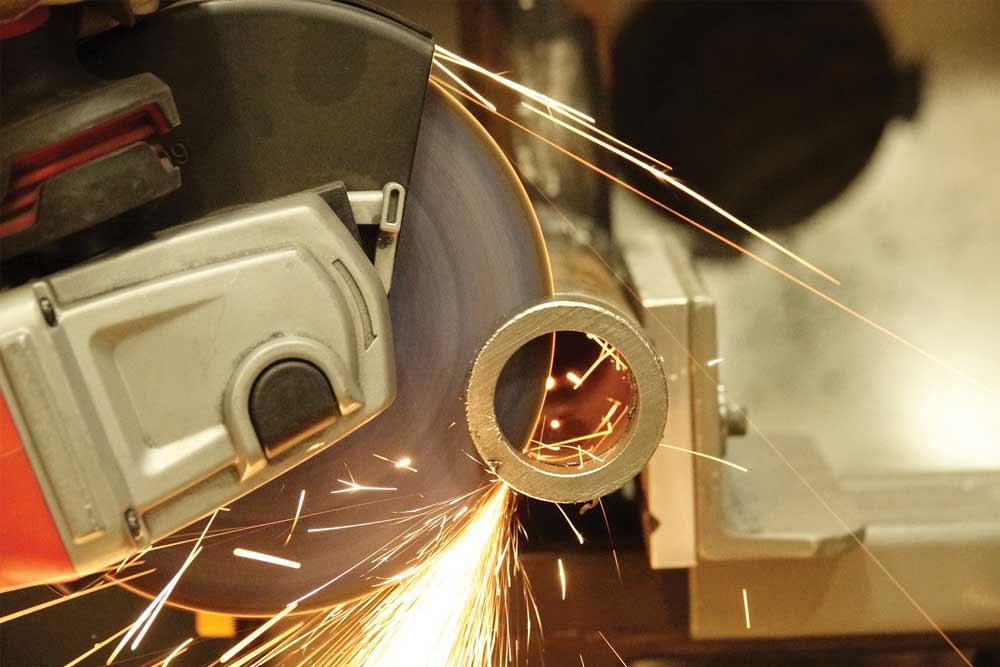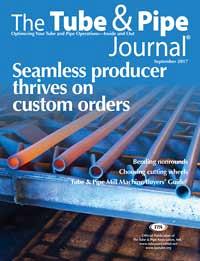Senior Product Manager, Welding and Fabrication
- FMA
- The Fabricator
- FABTECH
- Canadian Metalworking
Categories
- Additive Manufacturing
- Aluminum Welding
- Arc Welding
- Assembly and Joining
- Automation and Robotics
- Bending and Forming
- Consumables
- Cutting and Weld Prep
- Electric Vehicles
- En Español
- Finishing
- Hydroforming
- Laser Cutting
- Laser Welding
- Machining
- Manufacturing Software
- Materials Handling
- Metals/Materials
- Oxyfuel Cutting
- Plasma Cutting
- Power Tools
- Punching and Other Holemaking
- Roll Forming
- Safety
- Sawing
- Shearing
- Shop Management
- Testing and Measuring
- Tube and Pipe Fabrication
- Tube and Pipe Production
- Waterjet Cutting
Industry Directory
Webcasts
Podcasts
FAB 40
Advertise
Subscribe
Account Login
Search
Save time and money by optimizing cutting wheel selection
How you choose it and use it can make a big difference in the bottom line
- By Rick Hopkins
- August 25, 2017
- Article
- Arc Welding
Companies can save money in a pipe welding operation in many ways. It’s difficult or perhaps impossible to cut back on fixed costs or labor, so reducing the costs of consumables, such as cutting and grinding wheels, often is the primary target. However, this can lead to inefficiencies, and it’s easy to overlook the hidden costs. From reducing downtime to improving productivity, many operators realize in many cases that buying higher-priced, high-performance cutting and grinding wheels ultimately provides the lowest overall cost of use.
Selecting the proper cutting wheel for the job and following best practices for its use can lower costs by reducing the amount of filler metal needed to produce a quality weld, decreasing rework, and prolonging the effective cutting life of the wheel. In addition, it can minimize labor and downtime for wheel changeover.
Good Preparation Leads to Good Welds
Any good weld is the product of good, thorough preparation. Preparing a joint that is smooth and uniform results in a clean, strong weld. Wide or uneven joints require additional filler material, which usually is the most expensive consumable associated with welding. Poor joint preparation can lead to additional passes and can result in welds that are structurally weak and not very aesthetic.
The type of material being cut is one of several factors to consider when choosing a cutting wheel. Common materials used in tube and pipe applications include mild steel, chrome-moly steel, stainless steel, titanium, INCONEL® alloy, and aluminum. When cutting stainless steel and aluminum, choosing a wheel that is rated contaminant-free (inox, from the French word inoxydable) is important. These materials commonly are used in the food service and medical industries.
A critical question concerns versatility. Are you always working with the same material, or do you work with several material types? Do you need to purchase several products, or do you need a one-size-fits-all option?
Cutting Wheel Materials
The pipe’s outside diameter and wall thickness dictate the most appropriate tool size. Consider these common tool sizes and the recommended maximum cutting diameters when selecting a cutting wheel:
- 4.5-in. grinder: up to 3⁄4-in. OD
- 6-in. grinder: up to 21⁄2-in. OD
- 7-in. grinder: up to 3-in. OD
- 9-in. grinder: up to 31⁄2-in. OD
While it is possible to cut larger-diameter pipe with smaller-diameter wheels, remember the importance of a perfectly clean, straight seam to prepare for the weld. A wheel diameter that will cut straight through the pipe’s diameter will produce the most even cut line and weld seam.
Grain type is the next consideration. Three cutting grains commonly used in bonded abrasive cutting wheels are aluminum oxide, zirconia alumina, and ceramic alumina.
• Aluminum oxide. Aluminum oxide wheels use soft bonds that aren’t too resistant to heat, resulting in a cut that is fast, smooth, and easy to control. However, this type is the least durable of the three.
Aluminum oxide wheels are the least expensive and have a high initial cut rate, but the tradeoff is a short product life. As a result, aluminum oxide is suitable for cutting mild alloys such as carbon steel and is a good choice for cutting thin gauges and doing repair work, but it is not considered the best option for cutting harder or more exotic metals.
• Zirconia alumina. Zirconia alumina is harder and tougher than aluminum oxide, so it maintains sharpness and lasts longer than aluminum oxide. Its increased toughness makes it more heat-resistant, and it can be used with harder bonding materials, resulting in a wheel that cuts faster and lasts longer than an aluminum oxide wheel. A zirconia alumina wheel comes at a higher cost than an aluminum oxide wheel, but it gets the job done quicker with fewer changeovers. The result usually is a lower overall cost of use.
• Ceramic alumina. Ceramic alumina grains fracture and self-sharpen through the cutting process and are very durable. As a result, ceramic alumina wheels maintain sharpness and cut rate for roughly 75 percent of their lifespan before an operator feels a decrease in cutting performance. Ceramic wheels have the highest initial cost but arguably have the lowest long-term cost.
Because ceramic grains need to fracture to maintain sharpness, tool speed is important. Using a ceramic alumina wheel with an underpowered tool can prevent the operator from realizing the full value of the grain. The ceramic alumina grain can cut most material types.
A thicker-than-necessary wheel generates excessive heat and friction, which are the enemies of any cutting wheel and can greatly affect wheel life. Prolonging wheel life is a matter of minimizing the surface contact to reduce friction and heat; to minimize surface contact, choose the thinnest possible wheel that will get the job done.
Reducing Overall Costs
In small shops that focus mainly on carbon steel, thin gauges, or repair work, an inventory of aluminum oxide cutting wheels might be the way to go. However, as the shop size increases—and the distance from work cells to the tool crib gets longer—and the mix of alloys grows more complex, zirconia alumina or ceramic alumina might make more sense. They help to combat the hidden costs associated with changeovers and inventory.
First, while, cutting as fast as possible is an obvious benefit to productivity, cutting as long as possible is perhaps just as critical. A 30-second wheel change can be costly when it involves a lengthy walk to the tool crib. Time studies have shown that a wheel change can take up to 40 minutes. If each operator changes wheels four times per day, the downtime amounts to 30 percent of a shift.
In such a case, a ceramic alumina wheel has a significantly lower overall cost of use than an aluminum oxide wheel. While the ceramic wheel costs more initially, it cuts much faster and lasts longer, requiring less frequent changeover, minimizing downtime and improving labor productivity.
Second, when working with a variety of materials and using several cutting wheel types, inventory management and related costs also are concerns. Keeping two or three cutting products in inventory gives the operator the maximum number of choices, but purchasing cutting wheels in three types and four sizes is a minor headache. Buying only ceramic alumina, which can cut anything, simplifies purchasing, storing, and resupplying this consumable.
Best Practices Can Save Money
Cutting technique affects wheel performance. The important factors involve pressure, friction, and vibration.
First, let the wheel do the work. Don’t plunge the wheel all the way through the workpiece, and don’t push too hard on the wheel, which causes the speed to drop. Zirconia alumina and ceramic alumina grains work best at high speeds.
Second, minimize surface contact and friction as much as possible. This reduces heat, which ultimately allows for the wheel to cut faster, smoother, and cleaner. Heat also breaks down the wheel faster, so a cooler cut prolongs wheel life. Before starting the cut, hold the wheel next to the tube or pipe to better understand how deep the cut should be. The depth of the cut is dictated by the thickness of the metal. Use consistent motion through the cut without pushing or plunging. Using motion rather than pressure to perform the cut minimizes friction and heat.
Third, minimize vibration by performing the cut as close as possible to the mounting or clamping point while still allowing adequate clearance for hands, the cutting tool, and the guard. The greater the distance from the clamping point, the more vibration translates through the workpiece into the wheel, which causes premature breakdown or potential failure.
About the Author
Rick Hopkins
1 Weiler Drive
Cresco, PA, 18326
570-595-7495
About the Publication
subscribe now

The Tube and Pipe Journal became the first magazine dedicated to serving the metal tube and pipe industry in 1990. Today, it remains the only North American publication devoted to this industry, and it has become the most trusted source of information for tube and pipe professionals.
start your free subscription- Stay connected from anywhere

Easily access valuable industry resources now with full access to the digital edition of The Fabricator.

Easily access valuable industry resources now with full access to the digital edition of The Welder.

Easily access valuable industry resources now with full access to the digital edition of The Tube and Pipe Journal.
- Podcasting
- Podcast:
- The Fabricator Podcast
- Published:
- 04/16/2024
- Running Time:
- 63:29
In this episode of The Fabricator Podcast, Caleb Chamberlain, co-founder and CEO of OSH Cut, discusses his company’s...
- Trending Articles
Zekelman Industries to invest $120 million in Arkansas expansion

3D laser tube cutting system available in 3, 4, or 5 kW

Corrosion-inhibiting coating can be peeled off after use

Brushless copper tubing cutter adjusts to ODs up to 2-1/8 in.

HGG Profiling Equipment names area sales manager

- Industry Events
16th Annual Safety Conference
- April 30 - May 1, 2024
- Elgin,
Pipe and Tube Conference
- May 21 - 22, 2024
- Omaha, NE
World-Class Roll Forming Workshop
- June 5 - 6, 2024
- Louisville, KY
Advanced Laser Application Workshop
- June 25 - 27, 2024
- Novi, MI



























